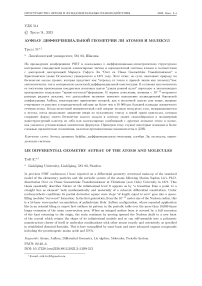Lie differential geometry Aufbau of the atoms and molecules
Автор: Trell E.
Журнал: Пространство, время и фундаментальные взаимодействия @stfi
Рубрика: Гравитация, космология и фундаментальные поля
Статья в выпуске: 3-4 (44-45), 2023 года.
Бесплатный доступ
In previous PIRT conferences I have reported on a differential geometry structural make-up of the standard model of the elementary particles and the periodic system of the atoms following Marius Sophus Lie’s Ph.D. dissertation Over en Classe Geometriske Transformationer at Christiana (now Oslo) University in 1871. This thesis essentially describes Nature at the infinitesimal level it appears as by “a transition from a point to a straight line as element” both mathematically and materially of a coherent differential constitution. Under nucleosynthetic conditions its partial derivative square wave steps “of length equal to zero” goes into a space- filling modular “curve-net” formation. In the first generation, from the 10-15 meter size of the Nucleon radius, this is a bi-layer wave-packet accumulation of palindromic Bohr Aufbau configuration, whose repeated application like in an oriental tiling or carpet first outlines its pattern in the periodic table over the more than 10,000 times larger extension of the atom cross-section area. When an integral surface layer is covered by a full excursion of the knot returning to the origin, the train continues by moving upward the Nucleon shaft to a new facet of the crystal which retains the shape of its infinitesimal module and so can self-assemble into a polymeric nanostructure cluster of itself or molecular combinations with other atoms exactly and extensively as specified in established chemical formulas. This is here exemplified by some basic and more advanced organic compounds including the proteinogenic amino acids and DNA.
Atoms, aufbau, differential geometry, lie algebra, molecules, periodic system
Короткий адрес: https://sciup.org/142240759
IDR: 142240759 | УДК: 514 | DOI: 10.17238/issn2226-8812.2023.3-4.299-313
Текст научной статьи Lie differential geometry Aufbau of the atoms and molecules
In his Norwegian Ph. D. thesis Over en Classe Geometriske Transformationer at Christiania (now Oslo) university in 1871 [1],[2], Marius Sophus Lie’s quite profound subject was the “nature of Cartesian geometry”. On par with the leading geometers of the time [3] his revolutionary advance was the discovery of the “fundamental relation between the Pliicker line geometry and a spatial geometry whose element is the sphere” [1],[2] and the ”study of the space relative to the given line complex” of this “according to the general theory for reciprocal curves”, which “transform the spaces r’s straight lines into the space R’s spheres”. As shown in Figure 1
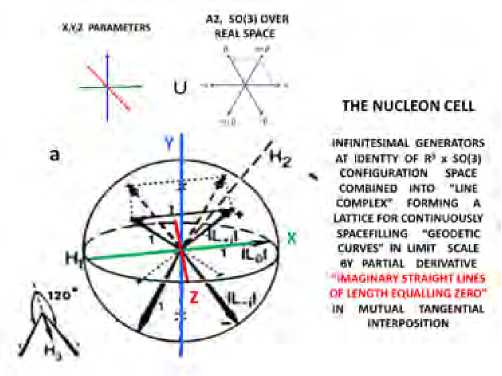
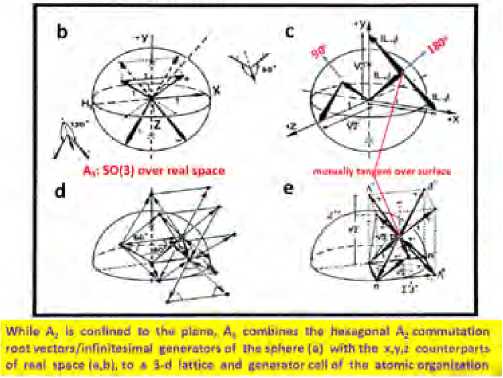
Рис. 1. a,b) Nucleon projective line complex of R3so (3) configuration space. c) Orthogonal root vector sequences. d) Hexagonal root vector lattice. e) Hexagonal SO(3) root vector bundle in orthogonal R3 cell. These and following figures, many from earlier PIRT meetings, with permission from IMBIC
it is a digital “line congruence” [Ib.] system “fundamental. . . in classical differential geometry” [4] and formed as a union between the parameters of Euclidean space and the “sphere’s rectilinear generatrices” [1],[2], and has the characteristics of the Nucleon as can be illustrated in Figure 1 a,b, while Figure 1 c-e shows the “complex of curves that are enveloped by the line-complexe’s lines” whose “curve-net. . . we in the following designate the line-complexe’s main tangential curves”. [Ib.]
A. Methods
In this way a commutating root vector lattice is spanned in which the surface and internal symmetries, transformations and interactions and other Standard Model events of the elementary particles – which were not known at Lie’s time – can be directly reproduced [5]-[14]. But also the external; periodic table, atomic and molecular panorama can be displayed in the Lie line congruence system [10]-[14]. Its identity line-complex (Figure 1 a,b) combines the orthogonal and spherical infinitesimal generators to a common origin of the two reciprocal “characteristic curves. . . which are determined by the curve complexe’s c and C” parts, and “the two spaces are thus mapped into each other” by both’s “image-curve enveloped by the other complexe’s lines” [1],[2]. Figure 2 outlines this mutual realization of the ground Euclidean and spherical “geodetic curves” [Ib.].
In order not to clog up from start, this realization has to be bisected in two complementary longitudinal strands (Figure 3 a) simultaneously emitted in sequences of various length of their combined or separate R3 and SO(3) strings and thus incomplete but still maintaining a “general reciprocity between the figures in the two spaces” [1],[2]. So in the early universe there would be an isotropic distribution of such literal half measures occupying the volumes and figures of the full elements and thus appearing as ready e.g. Neutrons and Electrons/Positrons plus straight 〃 and zig-zag 7 rays of their respective lattice edges, but except for occasional encounters unable to fill out their saturated “material bodies”. [Ib.]
However, there are bound to be some fluctuations and irregularities in the primordial vapor [12], and they will build up and aggregate over time to reach after billions of years the present astrophysical conditions, which changes the situation (Figure 3b). The stellar clashes and fanfa ■
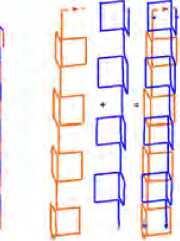
a
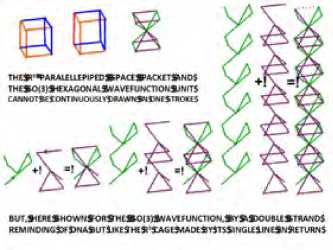
b
VS^8A
□dddr .rfabjpb
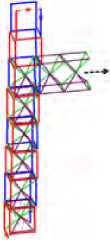
c
^>t
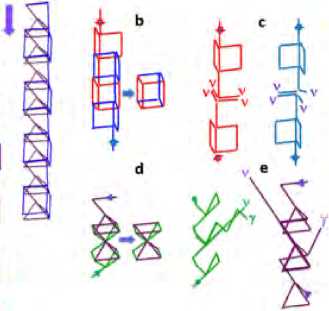
Рис. 2. a) Non-overcrossing concatenation of Euclidean frame space infinitesimal generators to outgoing 五 3 characteristic curve varieties (red) complemented to full cages by returning flank (blue). b) same in SO(3) and c) integrated R 3 SO ⑶ line congruence
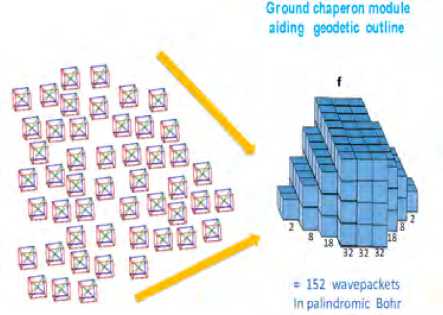
orfartdl distribution
Рис. 3. a) Reciprocal spherical transformation complex-curves in complementary flanks with wave-packet generation in contralateral meetings while ipsilateral confrontation gives annihilation (not shown). b-c) Same in ‘cage space’ and d,e) ‘wave space’ curves. f) The nucleosynthesis products, here wave-packets, find further space-filling via Bohr Aufbau piling implosions converge the diverse rudimentary “curve-lines” from all directions together so that they will “touch” [1],[2] in the interior to produce a variety of outcomes, from annihilation with “ and 7 discharge when ipsilateral contours confront, to entanglement superposition when contralateral couples meet to generate frame or wave or wave-packet boxes/bricks, all of equal parallelepiped perimeter (Figure 3 a-e). Squeezed together in the nucleogenetic crossfire and coming out in its exhaust they must find an optimal packing order to continue their space-filling without instantly jamming, and the solution for the mixture while shown here only by the wave-packets is a common hierarchical Bohr Aufbau (Figure 3 f) [15].
B. Results
As reported in earlier papers [10]-[14] the construction starts with a consecutive piling of a flat-bottomed fundament complemented by a flat-roofed cap and after further tangential modifications reaching the triangular form described in Figure 4 a. Each brick contains 12, in the R3SO⑶ wavepackets 2 X 12, line steps and the modules in each plane are tessellated in palindromic Bohr Aufbau order by 153 bricks, giving a peripheral versus central inertial moment = 153 X 12 = 1836 which is the same as the Proton/Electron mass ratio. The composition of the modules provides continuity/connectivity of their lines in all directions and the flat bottom/roof perpetuity of their crystal ascent. Figures 4 e and f further exemplify that they work at their infinitesimal level precisely as the intrastellar nucleogenetic processes where they fuse, also in here not shown burning sequences [10]-[14] , to the successive atoms and their spectrum up to Iron and then by marginal Neutron capture over the rest of the periodic table - and beyond [14]. This far-reaching structural identity and theoretical Lie geometry of space heritage and down-to-Earth Bohr Aufbau architecture plan cannot but verify the truth and reality of the system.

Рис. 4. a-d) Diagonal root vector module in triangular outline which can link laterally to inert H2 gas or be twisted to Deuterium and further to Helium module. e) Consecutive first. period isotopes. f ) Serial fusion Aufbau of first states of the second period
Next the stable(st) atoms of the second period are displayed in larger scale (Figure 5) because including the basic building blocks of organic chemistry, namely, beside Hydrogen in period 1, Carbon, Nitrogen and Oxygen. They are of mid-symmetric shape and provide a distinct set of jigsaw tesselation pieces filling space from the centre rather than from the periphery as is the mode in inorganich chemistry, albeit some atoms, e,g, Phosphorus and Sulfur may rearrange to take part in certain amino acids and DNA and ATP, respectively.
4beryllium
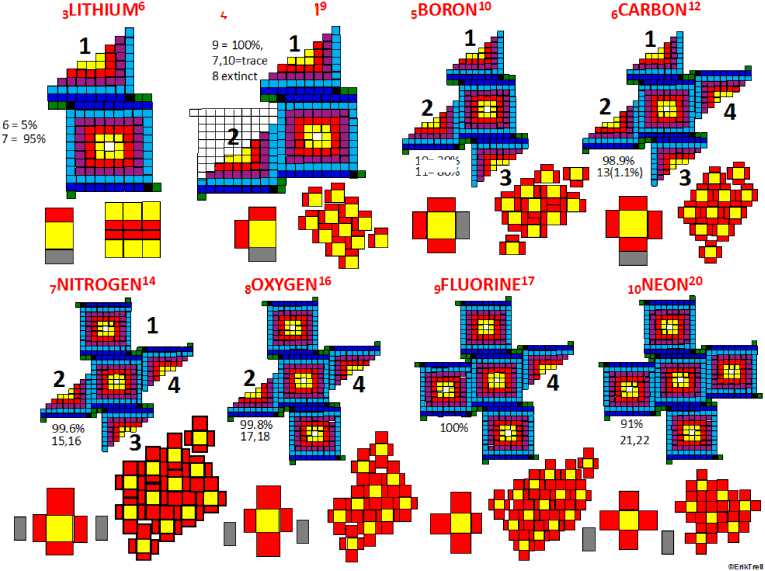
既 11=ЯГЖ
Рис. 5. Second period atoms in space-filling fine-grained Lego and simplified ‘Duplo’ [16] graphics, the latter of which is the actual form in magnification to atomic size. The numbers are oxidation sites. In all figures, the colors are those of the noble gas in respective periods
To visualize this and also to enable expansion from infinitesmal size in the order of 10 - 15 to 10 - 14 meter to the up to 10,000 times wider atomic size a simplified ‘duplo’ representation [16] is applied and repeated like the knot in an oriental rug or tiling, first over the cross-section “integral surface” area and when a layer is covered there it moves up to the next and so on till of height for a gaseous, liquid or solid state. The size has grown to the ?ngstr?m range and the apparent propagation velocity due to the volume increase diminished from the speed of light in the infinitesimal modules to the order of micrometer/second in the atomic blocks.
Next follow, in Duplo representation alone, the third period states (Figurer 6 a). Numbers in bold are oxidation states, in italics frequencies. In all figures, the colors are those of the noble gases in successive periods. One notes the tendency to quadratic/parallelepiped outline in the module formation even to the extent of uniqueness by Neutron marginal filling, e.g. in the only isotopes of Sodium and Phosphorus (Figure 6 b).
This remains the ‘game of Lie’ [14] algorithm in all following periods. Up to Iron the formation is mainly in fusion processes (except in Scandium where it is rapid Neutron capture). From Iron where the square contour is firmly established, the chief mechanism is marginal accretion by initially slow and in heavier states rapid Neutron capture, and in the heaviest by synthesis. All observed isotopes and channels occur in the realization as in reality, establishing with astronomic probability the actual identity between them.
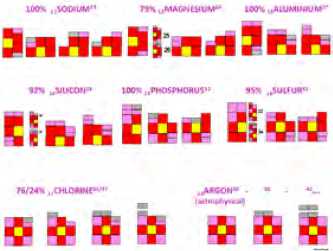
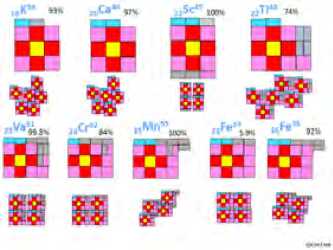
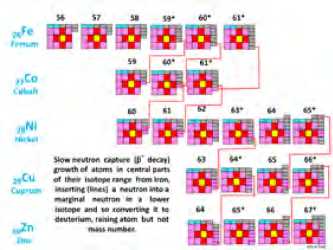
abc
Рис. 6. a) Third period atoms in ‘Duplo’ graphics, which is the actual form in magnification to atomic size. b,c). Fourth period from Potassium to Zinc
Then follow the rest of the fourth period atoms (Figure 7).
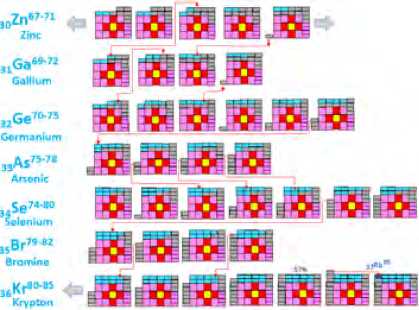
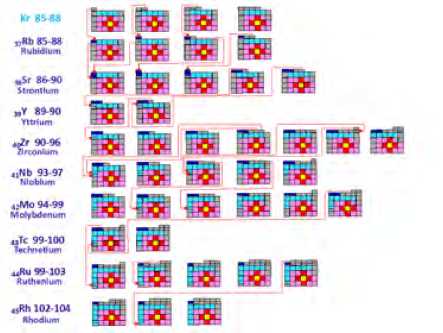
中 0 94-99
cRh 102-104
a
Рис. 7. a) Remaining fourth period atoms and their central isotopes. Like in all other atoms they are planefilling by aggregation which does not mean they are stable. Slow Neutron capture beta channels are shown like in other figures. Note complete alpha filling in Krypton. b) Initial states in the fifth period, including Technetium which has no stable isotopes
a
Fifth period is fulfilled in Figure 8a and sixth period is started in Figure 8b
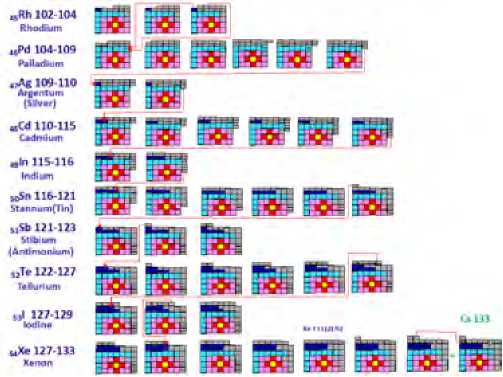
a
Рис. 8. a Fifth period concludes it layer with full alpha blocks in Xenon. b) Start of sixth period
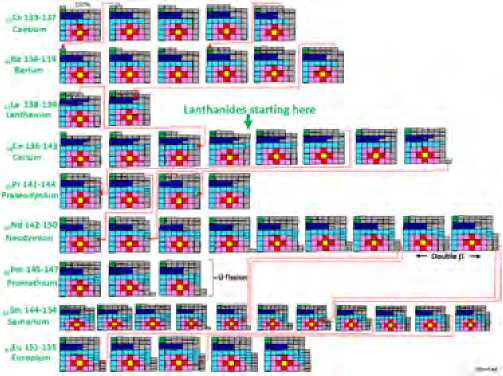
b
Sixth period continues in Figure 9.
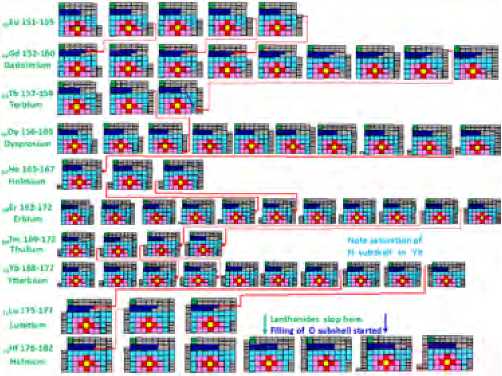
a
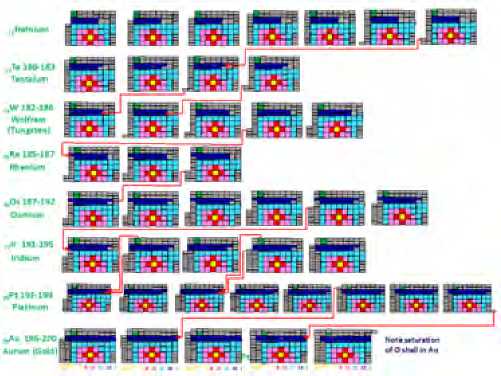
b
Рис. 9. Continuation of sixth period till gold
And concludes in Figure 10 a. Seventh period starts in Figure 10 b.
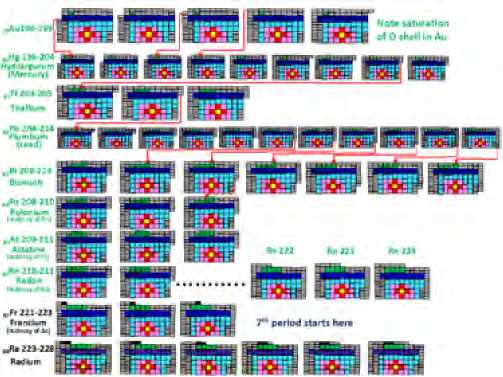
a
Рис. 10. a) completion of sixth period. b) Start of seventh period. Alpha channels are shown. In the seventh period most states are synthetic and extremely short-lived. But their outlines can all be step-by-step reproduced exactly as they appear in observations and experiments, next in Uranium to Hassium (Figure 11)
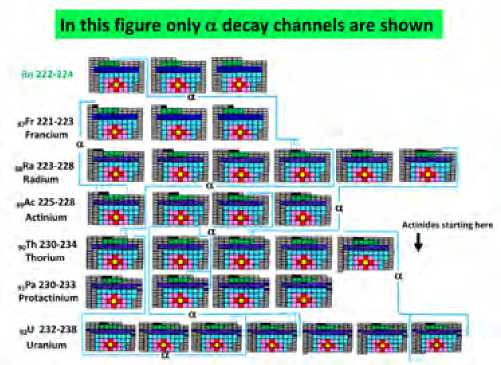
b
Now approaching the end of the cavalcade it must be emphasized that it contains a lot of information not further commented upon in the text but marked out in the figures; the Lanthanides, the Actinides, the covering of subshells etc. in the same order as in Reality and bringing so strong evidence that it is indeed the true “Nature of Cartesian Geometry” which is literally surfacing that it is beyond any denial.
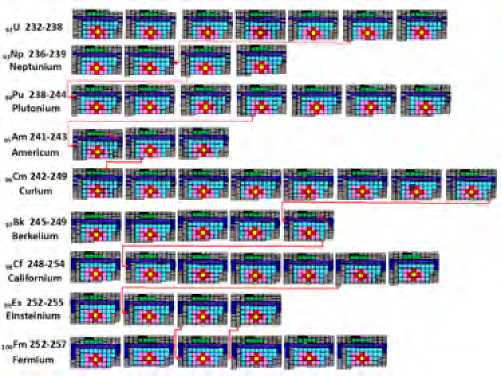
a
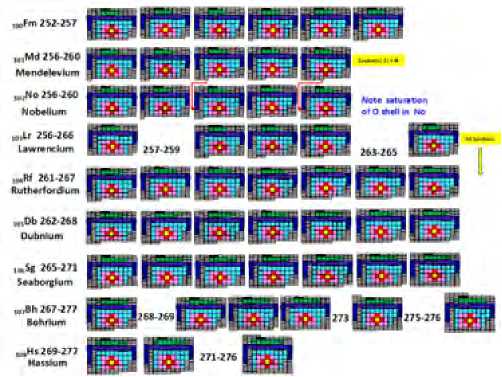
b
Рис. 11. Uranium to Hassium
A larger jubilee portrait of this finale is therefore granted (Figure 12):
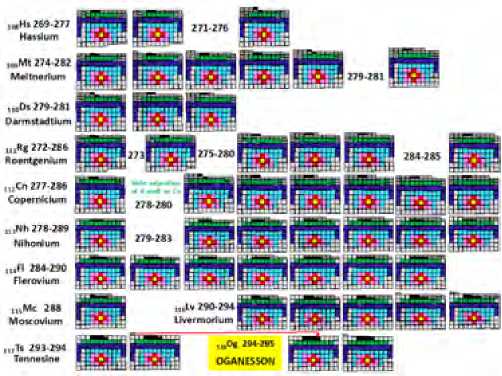
Рис. 12. Finale of period seven,. concluding the stepwise meandering over the periodic table to exactly reach and replicate Oganesson - and the first step of period eight.
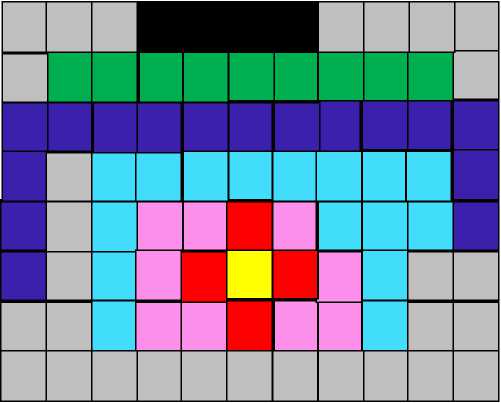
In its successive completion Oganesson is therefore both Integral and Icon of the presently known Periodic Table; canvas as well as palette of all the patterns within its perfectly rectangular frame; all the shells with 1 + 4 + 9 + 16 + 16 + 9 + 4 saturated alpha bricks, that is, completing the seventh round of a full theoretically possible eight-period Bohr Aufbau cycle [14], plus 2 x 29 = 58 excess Neutron contour fillers in right K L M N O P Q positions, and everything tiled by just two brick varieties; a quadratic and its latitudinal half, and laid in alternating, Fermionic and Bosonic order and hence exhausting all forms under them so that they can be applied in all scales and media It is a new hierarchical level of realization where the enormously size-increased, sharply shape-preserved atomic modules can gather with likes to flat-roofed/floored solid crystals of recognized atom outlook or be directly applied as building bricks in a polymeric nanostructure self-assembly of themselves and molecular combinations with other atoms.
This will here be performed in the organic chemistry atoms and compounds by as many pictures with as little text as possible, letting the results talk [17]. Figure 13 a shows the basic construction set as jig-saw pieces of the cross-section figure and mosaic blocks of the whole body including isomeric forms of Hydrogen, Carbon, Nitrogen and Oxygen while figure 13 b compares some self-assemblies of Carbon atoms to orthogonal and diagonal aggregates with a graphical reconstruction of Graphene as balls and sticks and empty space and a photo of the actual surface.
Next the basic hydrocarbons and the single building block hydrides of Nitrogen and Oxygen are surveyed (Figure 14 a) and then a larger image of water in two forms, one of which is proportionately intermingled in different types of ice (Figure 14 b).
In Figure 15 some further basic molecular combinations of the first and second period atoms with
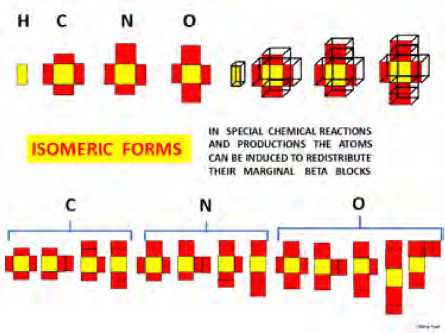
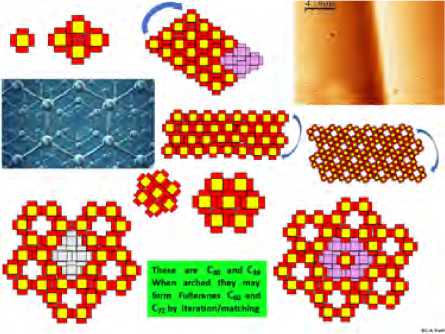
Рис. 13. a) Basic construction set of organic Carbon chemistry. b) Some self-assemblies of Carbon atoms. The orthogonal and hexagonal sheets can be very long and when of few layers folded to nanotubes and arched into domes and Fullerenes, e.g. the smallest C60
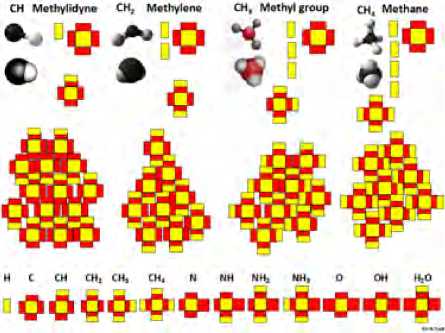
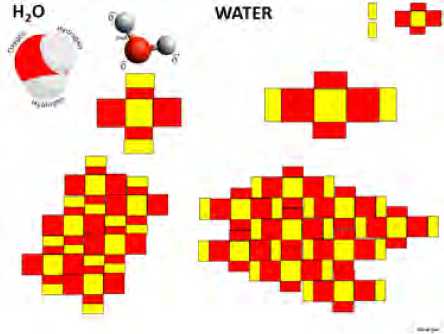
Рис. 14. a) Single building block hydrides of Carbon, Nitrogen and Oxygen. b) Water. Ball and stick and space-filling globular images for comparison taken from open Google/Wikipedia picture galleries
each other are surveyed.
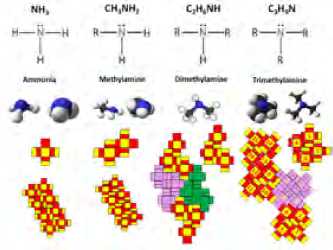
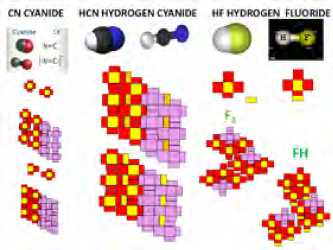
CyO 普鱷
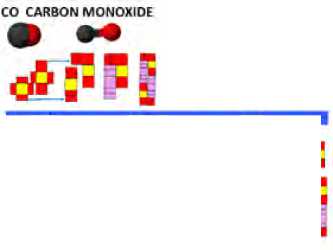

/VR *。整 占手 ^-55» £ %< ■■■■¥
abc
Рис. 15. a) Single building block hydrides of Carbon and Nitrogen. b) Cyanides, Fluorine, and Hydrogen Fluoride. c) Carbon monoxide and dioxide and, lower part, basic hydrides and oxides of Lithium, Beryllium and Boron. Note isomers needed in the compounds
Going to larger molecules Figure 16 demonstrates the build-up of the isomers ethenone and ethynol by a single CH turn and of ethanol by a larger amount of Hydrogen.
In the same tentative way (and with a certain amount of artistic freedom) the three main varieties of sugar and their compounds are reproduced by assorted combinations of six Carbon, six Oxygen and twelve Hydrogen atoms with D- and L-forms in Fructose and also other features as observed (Figure 17). It is reasonable that the different structural arrangements can alter e.g taste and other properties in ways that would be possible to examine and clarify in further studies.
The hydrocarbons form a large polymer class consisting entirely of Carbon and Hydrogen arranged
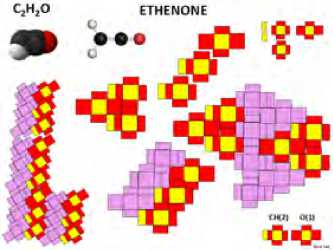
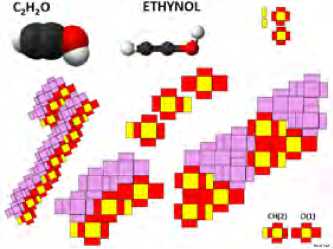
Рис. 16. Ethenone, ethynol and ethanol
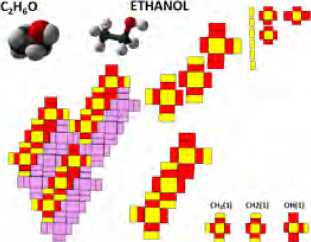
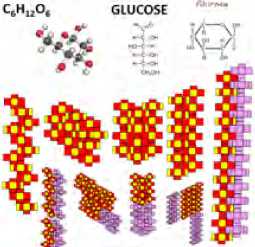
WQ000 ОФОООО -Jn-DODQDflDDDP

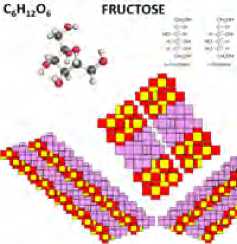
Рис. 17. The three main varieties of sugar

JHs 。 ,
GALACTOSE
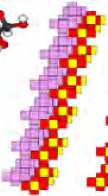
QQQOOQ 峭
ФФОО4О 3
I 口 : и Ll',I u 【 n 二 J「
in chains and cycles in a great number of variations and isomers and couplings to plastics etc. Here only lightest of them beyond methane, viz ethane, propane, butane and pentane are presented in their simplest execution (Figure 18 a) but it is possible to reproduce the whole family by their isomers and enantiomers by matching recombinations of their atoms and their branches and bindings. The same applies to the lipids of which here only cholesterol and its layering are displayed in comparison with present ball and stick and space-filling models (Figure 18 b). There is a good agreement, e.g. of the sole Oxygen, but the analog varieties fail in the global packing, which the digital version achieves by both definition and structure.
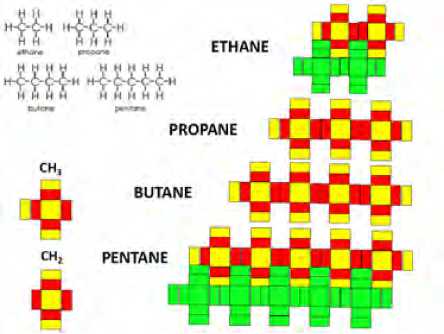
a
Рис. 18. a) Basic hydrocarbons and their spacefilling. b) Cholesterol. It is not spacefilling but like in the blood
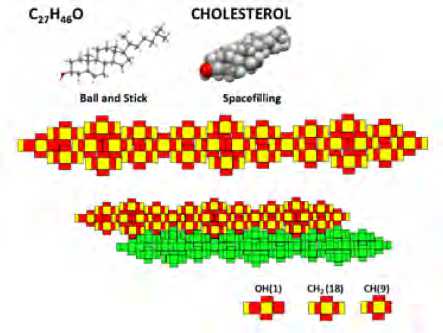
b
vessels longitudinally layerable with hooks for tissue integration.
So, after these examples, the outstanding, each enormous organic polymer fields are those of the amino acids and proteins and DNA/RNA. Starting with the former, the proteinogenic amino acids will be surveyed in alphabetic rather than systematic order, but it is hoped that many matters of construction and function will be illuminated in the series.
They include alpha helices, beta sheets, parallel/tube formation, rings, nests and others, and presumes a concrete building plan and elements with precise interlacing and interlinking, suggesting a common caliber and inclination. This is first illustrated in alanine (Figure 19), which is a non-essential amino acid but essential in the protein system, holding nearly nine per cent of its contents.
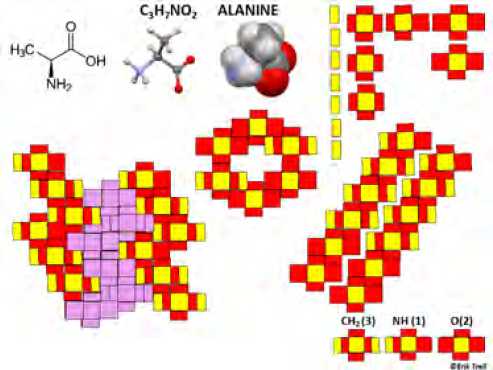
Рис. 19. a) Basic hydrocarbons and their spacefilling. b) Cholesterol. It is not spacefilling but like in the blood vessels longitudinally layerable with hooks for tissue integration.
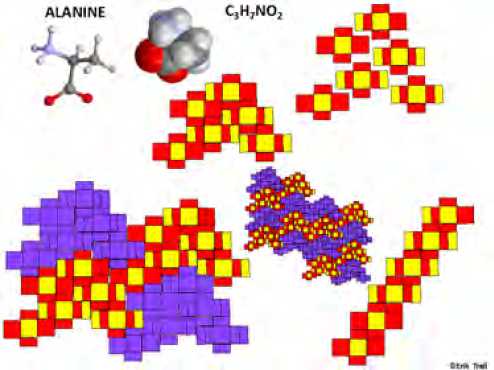
Then follow arginine to lysine. Their linear sequences are shown as much as possible following the ball and stick diagrams. and can from e.g. element placing order and interatomic forces have a wide variation of courses, just hinted at in the drawings (Figure 20). L forms are represented since used in the amino acids but in leucine a D form is shown for comparison.

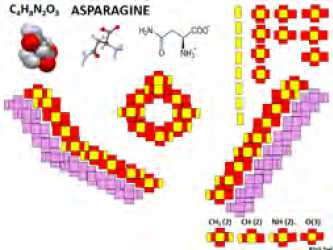
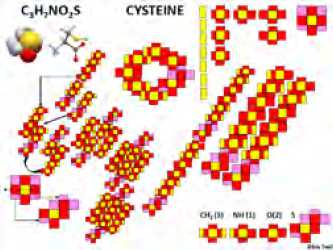
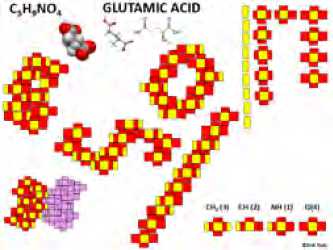
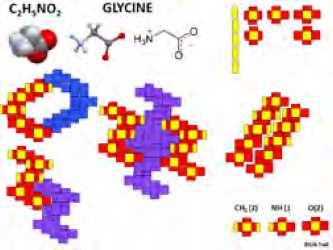
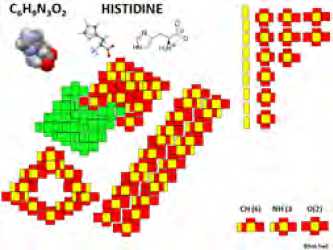
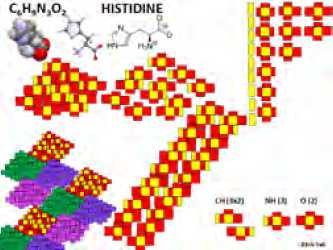
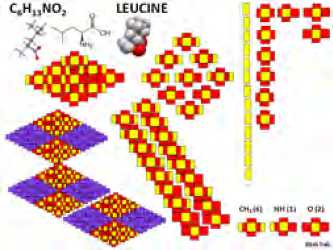

Рис. 20. Horizontal plane diagrams of arginine to lysine. As in Figure 13. Note parallel tracks (some color marked) enabling tube and other protein organelle formation. Note also end-to-end and side-congruity enabling inter- and intra-linking. A D-form in shown in Leucine for comparison
Now reflecting a bit on the case at this preliminary stage, one might begin with a floral parable where the ribosomes dispense the amino acids as seeds in sideway order to spread by a curved path over the smooth endoplasmic reticulum flower bed till they root and then grow up along their own coordinates in stem and twigs in a hydrous environments like crystal trees to form with others their fabrics and scaffolds and cages and pores with exact machine precision. . . One can only say that the diagrams may give a vague but still useful impression of this Terra Incognito. One day it will be possible to chart prospectively in detail so the sketching will go on, from methionine to valine (Figure 21).
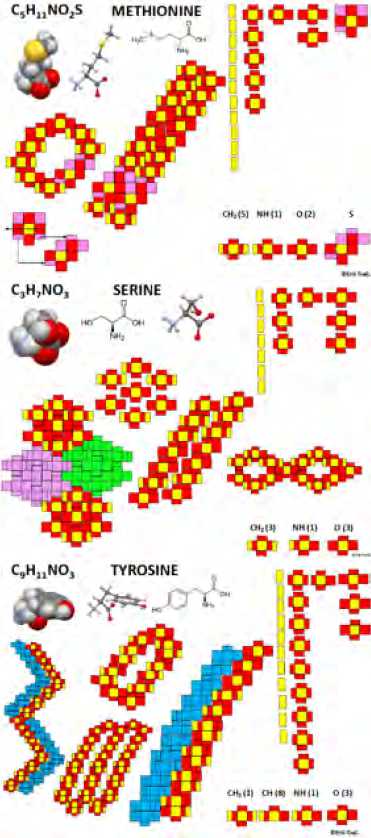
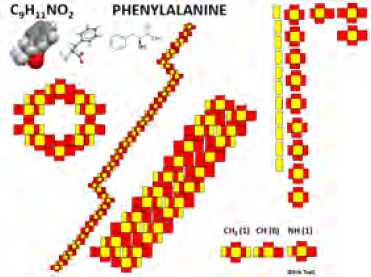
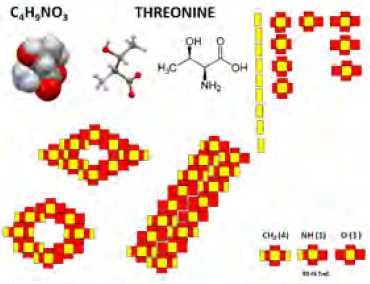
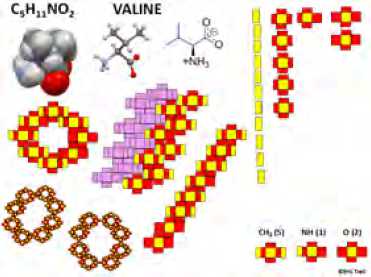
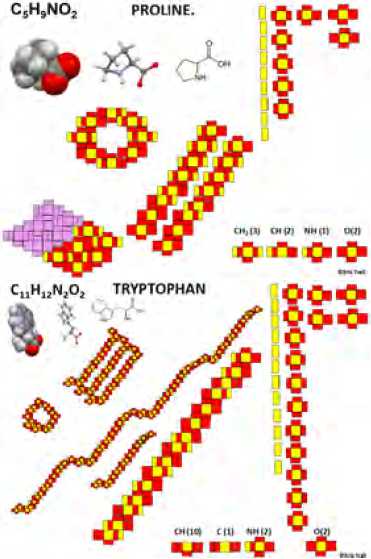
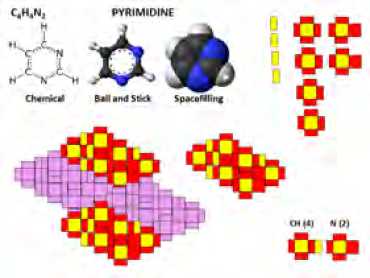
Рис. 21. Methionine to valine plus pyrimidine which is not an amino acid but included as a precursor of DNA nucleobases
Pyrimidine (Figure 21), of which the DNA nucleobases cytosine (C) , thymine (T) and guanine (G) are derivatives, hands over a defined slope, even width and collinear side contour to these and adenine (A) so that they can run parallel as space-filling covalent links between the DNA backbone strands. Shown here first in cytosine (Figure 22) they are composed in tight interlocking of monomer Hydrogen, Carbon, Nitrogen and Oxygen atoms alone and thus extremely strong
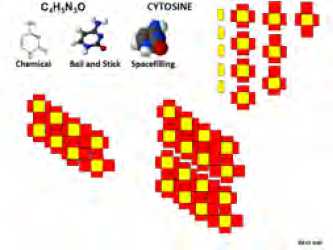
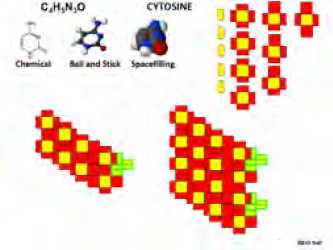
Рис. 22. Starting with cytosine, the DNA nucleobases will be shown in rising mass and length order, without and with marginal Hydrogen (marked in green for visibility).
lightweight alloys, in which most of the Hydrogen atoms are placed marginally to provide exact frontal boundary [18] while on the rear end there is a square click-in zipper lock profile. Next shown are thymine, adenine and guanine (Figure 23). They have different length, which is key to the C - G and T - A linking of the genetic code transmission and mRNA transcription of it.
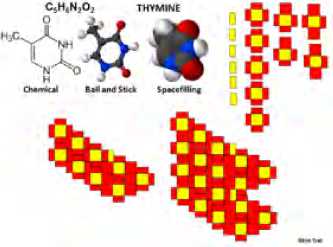
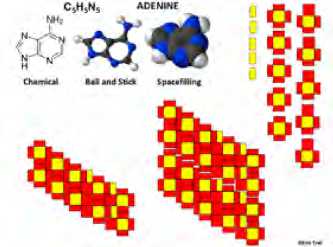
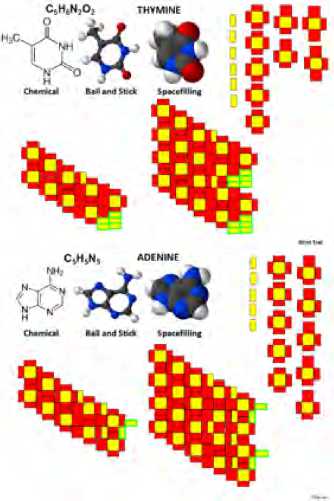
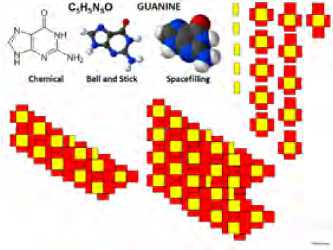
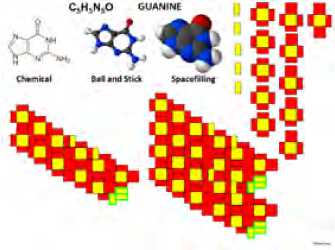
Рис. 23. The Thymine, Adenine and Guanine DNA nucleobases
The nucleobases are attached to a backbone which provides the two-component layout of the DNA molecule. Figure 24 a,b shows the self-assembly of the constituent atoms by the space-filling packing of five Carbon, eight Oxygen (one in ionic state), ten Hydrogen plus a phosphate and to
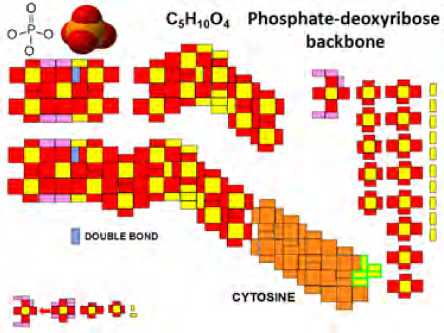
b
Рис. 24. Starting with cytosine, the DNA nucleobases will be shown in rising mass and length order, without and with marginal Hydrogen (marked in green for visibility)
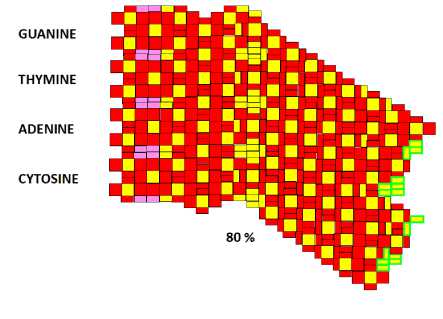
b
which the nucleobases are connected to the corresponding nucleotides which as demonstrated in Figure 24 b are of different length but laterally jigsaw layerable (and vertically by flat floor/roof). Frontally there is a specific profile which, as in RNA, suffices for transcription by a single strand. But DNA has a double helix for which there are many evolutionary reasons such as stability, repair and replication. The transcription is mediated by the same process as the DNA duplication which can be described as folding the “coding” nucleotide back to the start by a complementary “template” nucleotide returning to zip in with the backbone rear end from which a new round starts. By various support structures in a hydrous milieu the process assumes a tube form but is here visualized by the two sides folded out (Figure 25 a,b). One will note the key role of the marginal Hydrogen modules, as was first clarified both structurally and mathematically in the pioneering work of Rowlands and Hill 2007 [18]: “Hydrogen bonding. . . is precisely this which keeps the bases together in the two strands of DNA. . . appear to behave in a way pre-determined by the mathematical structure required for nilpotency”.
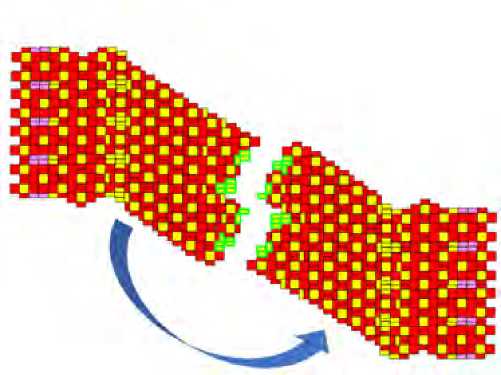
Рис. 25. a) Nucleotides in coding strand sheet are mirrored in returning template strand sheet. b) Brought together reciprocal nucleotides fuse and, as indicated by the horizontal line, in tube formation will zip in with the backbone rear contour forming one of the DNA contralateral grooves. b) when the template strand nucleoside(s) are complementary to those of the coding strand, closure will occur, forming the other DNA groove
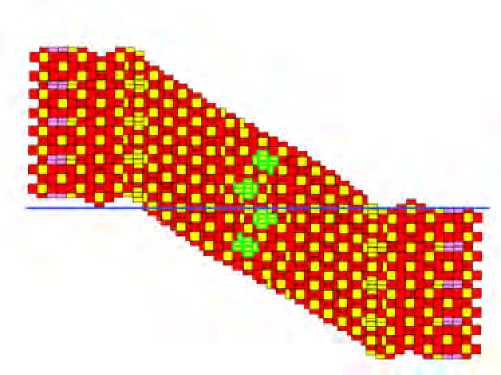
As illustrated in Figure 25, when the first coding nucleotide is a guanine complex, a cytosine is recruited to fill the seam by its complementary marginal Hydrogen modules, and when next thymine an adenine and so on. The recruitment is from the adjacent RNA polymerase pool and causes gaps in this which can immediately be translated to mRNA transcription. It can be mathematically characterized as a net zero balance over the folding groove [Ib.] and mechanically imposes a crucial dynamic and brick-laying role of Hydrogen in the chemical reaction. This also explains the anti-parallel course of the ‘returning’ template strand and how transcription as well as non-coding sequences proceed simultaneously with the coding strand.
Most of the above applies to RNA and ATP and other systems, too. The only mystery, also discussed in [18], is why thymine is replaced by uracil in RNA, but that can have to do with the up to hairpin bending of the RNA backbone since uracil is shorter than thymine but has equal e.g. binding potential. However, this is highly speculative and the present report stops short of RNA.
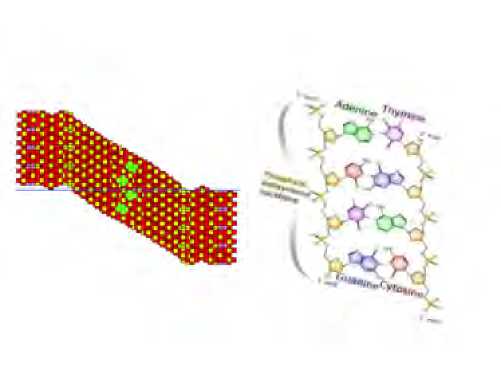
Рис. 26. a) Present and prevailing structure diagrams of a DNA segment in b) relation to whole molecule
THE CHROMOSOME IS A COHERENT DOUBLE-COILED LINEAR STRUCTURE WITH A CENTRAL SPIRAL STAIRCASE; AND THE LONGEST, NUMBER ONE, PACKS 248,956,222 BASE-PAIRS IN CYCUCAILY BENT TW0WAY5 UNEAR SEQUENCE TOGETHER WITH A TOTAL 3 ВІШОЫ IN THE 6 um WIDE NUCLEUS
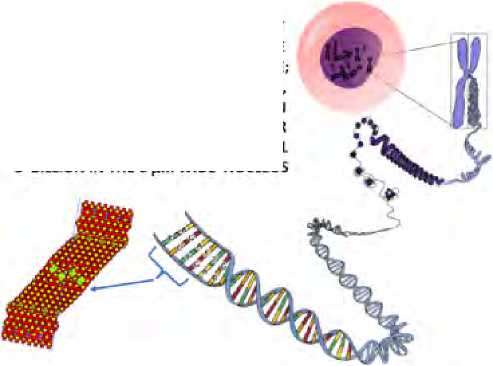
Of course, there are a legion of outstanding aspects of DNA as well. In this report only a superficial glimpse of a few albeit fundamental aspects is offered – rather convincingly, however. For the first time, and more realistic than current structure models (Figure 26 a), it is possible to come close and examine and test out both composition and mechanisms in detail. The approach, here covering just four basepairs of the gigantic DNA molecule (Figure 26 b), can be extended over this and its surroundings in an explorative way.
Conclusion
This article is intended as a descriptive case report as much as possible displayed by a representative, hopefully largely self-explaining picture series. Much of pertaining discussion and comments and figures is found in previous PIRT publications [10]-[14], and therefore only a few brief notes will be made of the, still quite disruptive, back to the future findings. They rest upon classical sources and are in no conflict with Quantum Mechanics (QM), where on the contrary it has long been known that the Aufbau principle as “compiled by Bohr and others” is instrumental in the “quantum mechanical explanation of the periodic system”. [19] And QM is in sole command when it comes to the atomic collision and decay processes with their plethora of Electron (and Positron) and Neutron lattice fragments and straight Neutrino and zig-zag Photon edge tra jectories, all in entanglement [20]. One further notes the analogy with the Clifford algebra three-vector units formed as a mixture of a parallelepiped and a rotation tensor with similar operative conduct [13],[14]. The space frame lattice engineering system is another parallel [12], especially useful in the reproduction of inorganic chemistry which is likewise feasible by application of the periodic system modules directly taken as both templates, elements and computer pixels of the material Aufbau and structure of the atoms and molecules and compounds. These studies are under way.
Список литературы Lie differential geometry Aufbau of the atoms and molecules
- Lie, M.S. Over en Classe geometriske Transformationer. Ph.D. Thesis, Kristiania (now Oslo,) University, 12 06 1871.
- Trell, E. English translation of Marius Sophus Lie’s doctoral thesis Over en Classe geometriske Transformationer. Algebras, Groups and Geometries 1998, 15, 396-445 and hadronicpress.com/lie.pdf, internet open accessible.
- Pluecker, J. Neue Geometrie des Raumes gegr?ndet auf die Betrachtung der geraden Linie als Raum Element; Druck und Verlag von B. G. Teubner, Leipzig, 1868.
- Bobenko, A.I., Schief, W.K. Discrete line complexes and integrable evolution of minors. arXiv 2015, 1410.5794v2, 1-30.
- Trell, E. Representation of particle masses in hadronic SU(3) transformation diagram. Acta Phys. Austriaca 1983, 55, 97-110.
- Trell, E. On rotational symmetry and real geometrical representations of the elementary particles with special reference to the N and D series. Phys. Essays 1991, 4, 272-283.
- Trell, E. Real forms of the elementary particles with a report of the S resonances. Phys. Essays 1992, 5, 362-373.
- Trell, E. Elementary particle spectroscopy in regular solid rewrite. AIP Conference Proceedings 2008, 1051, 127-141.
- Trell, E. Digital outline of the elementary particles via a root space diagram approach, J. Comput. Meth. Sci. Eng. 2013, 13, 245-270.
- Trell, E. Lie, Santilli, and nanotechnology. AIP Conference Proceedings 2014, 1637, 1100-1109.
- Trell, E.; Akpojotor, G.; Edeagu, S.; Animalu, A. Structural wave-packet tessellation of the periodic table and atomic constitution in real R3 x SO(3) configuration space. J. Phys.: Conf. Ser. 2019, 1251 012047, 1-15.
- Trell, E. A space-frame periodic table representation system testing relativity in nucleosynthesis of the elements. J. Phys.: Conf. Ser. 2020, 1557 012006, 1-10.
- Trell, E. From Photon to Oganesson. Lie algebra realization of the Standard Model extending over the Periodic Table. J. Phys.: Conf. Ser. 2021, 2081 012034, 1-12.
- Trell, E. A bottom-up ‘Game of Lie’ cellular automaton evolution in SO(3) root space both nucleating, crystallizing and space-filling the complete atomic realm. J. Phys.: Conf. Ser. 2022, 2197 012025, 1-15.
- Bohr, N. Der Bau der Atome und die physikalischen und chemischen Eigenschaften der Elemente. Zeitschr.Phys. 1922, 9, 1-67.
- Portegeis Zwart, S. Computational astrophysics for the future. Science 2018, 36, 979-980.
- Trell, E. Self-assembled nanostructures of atoms and molecules with examples of various organic compounds including the proteinogenic amino acids and DNA. Proceedings of IMBIC 2022, 11, 1-9.
- Rowlands, P. Zero to Infinity. The foundations of Physics; New Jersey, London, Singapore, Beijing, Shanghai, Hong Kong, Taipei, Chennai, World Scientific, 2007.
- Scerri, E.R. How Good is the Quantum Mechanical Explanation of the Periodic System? J. Chem. Ed. 1998, 75, 1384-1385.
- Aspect, A. Bell’s inequality test: more ideal than ever. Nature 1999, 398, 189-190.

